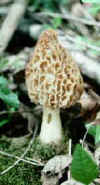| 3-30-09
So the famed April First is knocking at our door
and that signals Greenup Time, which brings thoughts of morel mushrooms
and consuming them.
But first of all, I would point out that the greenup
is going to be with us before the other smilemakers . . . as a matter of
fact, it is starting as I peck the keys of my beat-up old computer.
For “lo these many years” (to give this column
the touch of antiquity), I have written a few dozen times that neophyte
mushroom hunters MUST know what they are eating before they consume any
mushroom. Some are deadly poisonous; others merely make you sicker than
the proverbial dog.
Before I take the next breath, I point out that
there is no way a person with reasonable knowledge can mistake a morel
for a false morel because they do not look alike. The morel cap is pitted;
the false morel cap is not pitted; it has a smooth but wrinkled surface,
somewhat resembling the brain.
At this point, I might add that I have been hunting
and picking morels since I was a boy, and I have never seen a false morel,
nor do I know anyone who has.
Every spring I do find the barn red elephant ear
(a k a pig’s ear), and in days gone by I have eaten them. Many people do
not eat them (I now adhere to that category), but some people declare them
good chow. They may reach a size as big, or bigger, than a gallon paint
bucket. Most are less than six inches tall.
There is a fairly large family of so-called spearheads
(known also by several other names) that can be divided into two classes:
those with stem (stipe) and cap joined at the apex of the cap, and those
with cap and stem joined halfway to the peripheral border of the cap. I
tend to shy away from mushrooms of both groups, even though they do have
pitted caps. These mushrooms have a hollow, white stem (somewhat like the
true morels) but their stems are “mealy” feeling and usually very brittle.
I once returned home from a mushroom hunt with
a big bag of spearheads. Alone, and hungry as a black snake, to sate my
craving for food, I fried a skillet of the spearheads and ate them all
without other foods. In an hour I was nervous as a cat in a fish market.
I have since given these mushrooms a wide berth,
but if they are real fresh I bring them in for friends who swear by their
edibility.
As for the true morels, the neophyte hunter (I
still follow this rule occasionally) should take a good look at the perimeter
of the cap. That is where cap and stem are joined.
I am assuming that in the “cleaning” process,
morels are split lengthwise (stems, too) and soaked for a spell in cool
water. Run more water a few times to eliminate insects and mites in caps
and stems. Stems are fried, too, and as tasty as caps.
When I worked for a large daily newspaper, many
telephone callers asked if morels were edible if they contained insects
and mites. The answer was yes.
One evening a caller asked the big question about
mites. I gave him my standard answer, but the phone grew silent and I could
hear him say: “Hey, Mildred . . . has the trash man been past already?”
Mildred replied: “Yes!”
The phone still dead, the guy said under his breath
. . . “ XXX-XXXX-XX! . . . “ CLICK!
As for frying morels, I first make a mixture of
good crackers (I am finding that ordinary saltines work well), and flour
in equal parts. Cornmeal can be an optional.
In a cereal bowl (shallow sides), I mix egg and
milk in equal parts.
I heat iron skillet with one-sixteenth inch of
cooking oil (a little butter or margarine can be added). When a cracker
crumb sizzles a bit (not smoking hot) morel halves may be dipped in milk/egg
mix, rolled thoroughly in cracker crumb mix, and placed in a single layer
in bottom of skillet. While frying, the halves should be pressed gently
against bottom of skillet until golden brown on cooking side. At this point
more cooking oil should be added and all mushroom pieces turned to brown
second side.
Pressing morel pieces against skillet’s bottom
assures each half, or piece, of morel is exposed to cooking agent and heat.
Another rule of thumb that I think paramount to
new mushroom aficionados is to trust nobody’s judgment on mushroom edibility
unless you know that he knows. When you are certain it is edible . . .
dead certain . . . eat a small amount with other foods. Go slowly with
it . . . and other foods . . . before you dine big time.
Click on thumbnail
image for enlarged view.

|

|
|
True
Morel
|
False
Morel
|
There
is no way the true morel and false morel can be confused.
|

